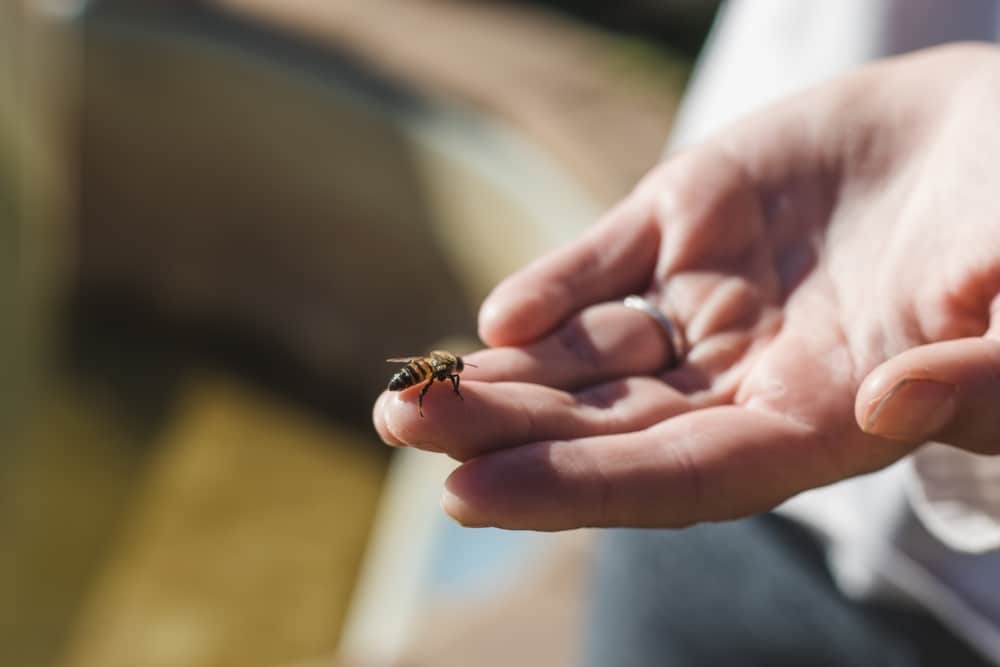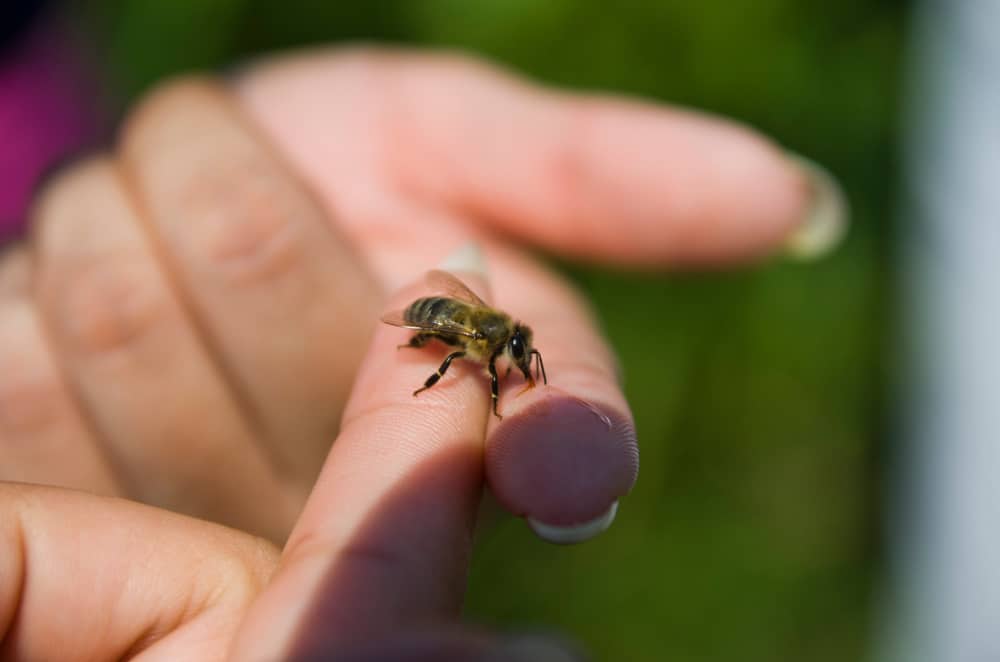Most people are aware of the fact that bees sting; well, at least some species do. But I know many people think bees are adorable (I’m one of them), so the temptation to touch one is genuine, but can you touch bees?
It’s not usually a good idea to touch bees since many can sting when they feel threatened. There’s no real need to touch them, either. It’s much better to observe them from afar and allow them the space they deserve.
Can You Touch Bees?

Touching a bee with your bare hands is never a good idea. While bees are not generally aggressive insects, they will sting if they feel threatened.
The thing with bees is that many of them possess a stinger, which they use in self-defense. While some species, like the female honey bee, die after stinging, they’ll still do it if they feel it necessary.
It is worth noting that male bees do not have stingers, regardless of the species. There is also a family of bees called the Meliponines called stingless bees because they lack a stinger.
That said, it still probably isn’t a good idea to touch them simply because they aren’t going to like it.
With all that in mind, an estimated 106 million human-managed beehives worldwide exist. Caring for bees requires attention to their behavior, gentle handling only where necessary, and protective clothing.
Protective Clothing For Beekeeping
If you’re considering taking up beekeeping (also known as apiculture), one of the first things I’d urge is to invest in good quality protective gear.
You’ll likely have seen the type of clothing beekeepers wear, and the most common is a full bee suit. These are designed with elasticated sleeves (made with elastic material) and legs and offer full protection to the entire body. They also have a full-head veil so the bees cannot reach your head and face.
Modern beekeepers may prefer a two- or three-piece bee suit. These are separate garments you can wear together to create a full bee suit, or in case you just need to perform a quick check, you might opt for just one or two of the items.
Bee suit protective gear includes:
- Protective pants
- Gloves
- A bee jacket (with or without an attached veil)
- A standalone veil
- Boots
What Are The Chances Of Getting Stung If You Touch A Bee?
If you touch a male bee or bees from the Melipolini family (the stingless ones), there’s a zero percent chance of being stung.
However, you risk getting a nasty, painful sting with other bees. Because of this, many people assume bees are naturally aggressive, but they’re incredibly docile.
The only exception is the Africanized honey bee, known for its angry nature and tendency to sting without someone provoking it.
All other bees simply want to get on with their business and be left alone. While I understand how fascinating these creatures are, it’s best to watch them rather than try to handle them.
When bees feel threatened, they sting. It’s as simple as that. And while you might not intend to harm them, they don’t know that.
I’d also warn you that when honey bees sting, they release an alarm pheromone. This is a chemical signal to other bees that there is danger lurking. The other colony members will come to the rescue, ready to fight off attackers. In this case, that’s you, and it could result in many more bee stings.
Is It True You Can Pet Bees?
It can be tempting to touch a bee, especially a bumblebee, with its fuzzy, teddy-bear-like appearance, feeding on a flower. But I would resist the urge because bees aren’t like cats and dogs; they really don’t want to be petted.
Imagine you’re a bumblebee sitting in the sun and taking nectar from a flower. Suddenly, a giant hand comes out of nowhere and starts prodding you. It doesn’t feel good, does it?
While you might think you’re not hurting the bee, your big hands on its little body won’t be welcome. It’s true that bumblebees aren’t typically afraid of humans, and there are even stories of them befriending people.
If you simply cannot resist the overwhelming urge to pet a bumblebee, then I suggest being as gentle as possible. It’s also essential to look for signs the bee is unhappy, which could it could display by lying on its back as a defense mechanism.
With other types of bees, such as honey bees and mining bees, for example, it’s probably best not to stroke them. They don’t have the same hairy bodies as bumblebees, so they won’t feel as good. That said, if the bee is happy to crawl on your hand, and you’re willing to stay still, there’s no harm in it.
Why You Shouldn’t Pet A Bee
I’ve talked about how you might be able to get away with petting a bee, but now let’s look a little more closely at the reality of the situation.
Primarily, I would never advise petting a bee because of the risk of being stung. This is especially true for people allergic to bee stings, as getting stung could be fatal.
What’s more, there isn’t any need to pet a bee. They’re small and delicate creatures, and a heavy-handed human could do some unintentional damage. As a bee lover, that’s the last thing I want anyone to do.
The best way to learn more about bees is to observe them as they visit your garden. It’s even possible to establish your own colony in a hive, which is a brilliant way to educate yourself. Plus, you’ll get some free honey!
Should I Let My Kids Touch Bees?
I love teaching my seven-year-old daughter about nature, and one way I do that is to involve her in my passion for bees. However, I will not let her handle or touch a bee simply because of the risk of being stung.
My daughter has never been stung by a bee, so I don’t know if she’ll have an allergic reaction. Allergies are common in my family, and according to doctors, allergies are typically hereditary. My grandmother had a bee sting allergy, so I wouldn’t want to risk finding out whether my daughter has one the hard way.
That said, teaching your children not to be afraid of bees is also important. Talk to them about what to do if a bee lands on them (remain calm and don’t make sudden movements) and educate them on the importance of bees.
There’s no need to fear nature, but we must give it the respect it is due.
When It’s Okay To Touch A Bee

If you’re anything like me and you love nature, then leaving a bee in distress or danger just isn’t an option.
Once, I found a bee trying to climb out of my garden swimming pool. The poor creature was soaking wet, and I couldn’t stand idly by to watch it drown.
However, handling a bee should be the last thing you try to do. I found that taking the net I use to clean the pool was the best way to remove the bee and put it in a safe location to dry off.
Of course, when rescuing a bee, you may have no alternative but to pick it up. In this case, I recommend very slow and careful movements. The reason for this is twofold. Firstly, any sudden or rough movements could frighten the bee, causing it to sting. Secondly, if you’re heavy-handed, you may unintentionally harm the bee.
I’d also strongly recommend wearing gloves to protect your hands from stings where they are available.
I have spotted bees in the past that look in terrible condition. Just like humans, bees age, and this can show up in many ways. The wings may look shabby, and the body may look shinier than usual, owing to hair loss.
While this can look distressing, bees like this will not recover, so trying to handle or help them will be useless. The best and most humane thing you can do here is to let nature take its course.
I’ve heard many people say things like, “Surely, it’s best to put the bee out of its misery.” But this isn’t a statement you can apply to all situations.
Sometimes, a bee may look damaged or ailing, but it may be resting. In many cases, a bee with a seemingly damaged wing, for example, may fly off a few minutes later. Unless you can be absolutely sure that the insect is dying, it’s best not to make that call.
Moreover, studies have shown that bees are unlikely to be able to feel pain. So, even if they are about to die, they won’t suffer in the way you and I would.
What To Do If You’re Stung By A Bee
A bee sting is inevitable, and bee stings cause mild to moderate pain and swelling at the sting site for most people.
It’s essential to remove the stinger by scraping a flat-edged object over it (a credit card works well.) The stinger can release more venom if you don’t remove it. While bee venom isn’t generally harmful to humans, you don’t want it coursing through your veins.
Once you have removed the stinger, I recommend washing the area with soap and warm water to reduce the risk of infection. You can also apply a cold compress to reduce swelling and take over-the-counter pain medication.
In most cases, the redness and swelling caused by the skin will begin to subside in anything from a few hours to a few days. It could take as long as ten days for the skin to completely heal for more severe stings.
For anyone allergic to a bee sting, it’s vital to seek medical attention as soon as possible. In the worst cases, when left untreated, bee sting allergies can be fatal.
If you aren’t sure whether you have a bee sting allergy, you look for the following signs and symptoms:
- Itching or flushed skin
- Swelling of the mouth, tongue, or throat
- Difficult breathing
- Changes to your heart rate
- Nausea and vomiting
- Diarrhea
- Feeling faint or dizzy
- Becoming unconscious
Different people respond to allergies in different ways, but it’s still essential to get the proper treatment to avoid complications.
Always consult with your doctor when you’re unsure or have any questions.


